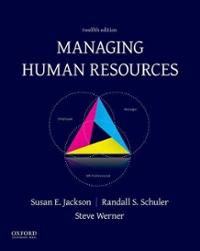Maria Dennis sits back and thoughtfully reads through the list of strategies that the unions committee gave
Question:
Maria Dennis sits back and thoughtfully reads through the list of strategies that the union’s committee gave her this morning. If her union is to rebuild the power it has lost over the past few years, it’s time to take drastic action. If the union continues to decline as it has during the last few years, it won’t be able to represent the members who voted for it to be their exclusive bargaining representative.
Maria was elected at her union’s convention to be the international president of the Newspaper Workers International Union (NWIU). At the time, she knew it would not be an easy job, and she eagerly looked forward to taking on a new challenge. But she had no idea just how difficult it would be to get the union back on its feet again.
The NWIU was founded in the late 1890s and was made up of newspaper typographers who were responsible for such tasks as setting type on linotype machines, creating the layout of newspapers, proofing articles, and printing newspapers. Members of the union typically completed a six-year apprenticeship, learning all the different tasks involved in the printing process. Before 1960, printing professionals were considered the elite of the industrial workforce. The craft demanded that typographers be literate at a time when even the middle and upper classes were not. Furthermore, printing was a highly skilled, highly paid craft.
Since the 1980s, however, the union has declined. Literacy is no longer a unique characteristic, and automation and technology has led to a deskilling of the craft. The introduction of video display terminals, optical character recognition scanners, and computerized typesetting has eliminated substantial composing room work, and the demand for skilled union workers has been reduced. The union experienced its peak membership of 120,000 in 1975.
During the 1980s, membership began a substantial decline, and in 2016, the total membership was less than 40,000. The reduced membership has resulted in other problems for the union. First, fewer members mean fewer dues, which are the union’s main source of revenue.
Consequently, the union is having some serious financial problems and is being forced to cut some of its services to members.
Second, the union is experiencing a significant loss in bargaining power with newspaper management. In the past, the printers were fairly secure in their jobs because there was a good demand in the labor market for individuals who could run the complicated printing equipment.
But the recent switch to automation and electronic publishing has eliminated many jobs and has also made it possible for employers to easily replace union employees. Anyone can be trained in a short time to use the new printing equipment. Therefore, if union members decide to strike for better wages, hours, and working conditions, management could easily, and legally, find replacements for them. In essence, the union is unable to fulfill its main mission, which is to collectively represent the employees who voted for it.
To solve the current crisis, Maria is considering five options:
1. Implement an associate member plan through which any individual can join the union for a fee of $50 a year. Although these members would not be fully represented on the job, they would get an attractive package of benefits, such as low-cost home, health, and auto insurance.
2. Attempt some cooperative labor-management relations programs, such as getting member representation on newspaper boards of directors or employee participation programs in the workplace.
3. Put more effort into political action. For example, lobby for labor law reform or for new laws more favorable to unions. Initiate action that would result in harsher penalties against employers that practice illegal union-avoidance activities, such as threatening to move the business if a union is voted in or firing pro-union employees.
4. Appeal to community leaders to speak out in favor of the union to improve public relations, to help recruit new members, and to encourage employers to bargain fairly when negotiating with the union.
5. Search for another union with which the printing professionals might merge, thus increasing their membership, strengthening their finances, increasing their bargaining power, and obtaining economies of scale.
Maria realizes that each of these options could have both positive and negative results and is unsure which strategy, if any, she should recommend for the union to pursue.
In less than 3 hours, however, she will have to present the list to the council with her recommendations.
CASE QUESTIONS
1. What are the strengths and weaknesses of each strategy?
2. What strategies could be employed to get new bargaining units?
3. What other types of services could the union offer to its members?
4. What would be your final recommendation? Justify your response.
Step by Step Answer:

Managing Human Resources
ISBN: 978-8522104291
12th Edition
Authors: Susan E Jackson, Randall S Schuler, Steve Werner





